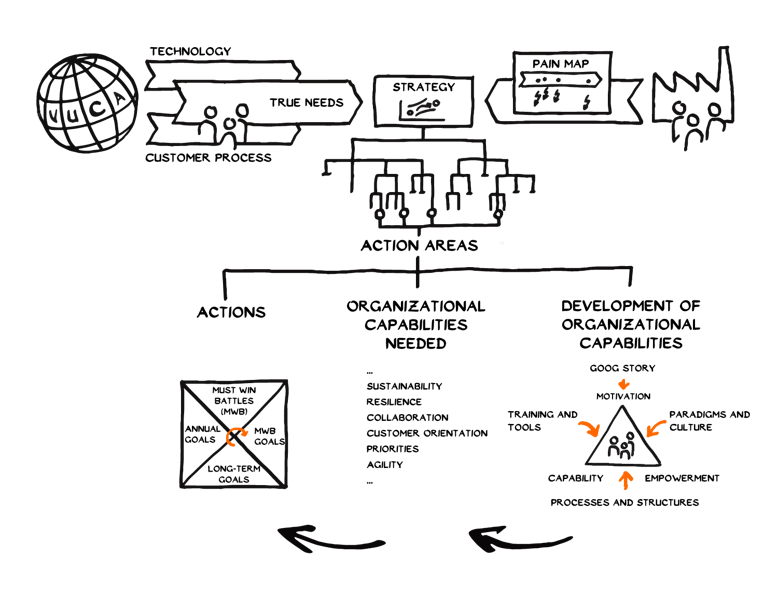
Energizing People in the Next Normal
The realization that volatility, uncertainty, complexity and ambiguity, or VUCA, can neither be stopped nor contained has been clear at least since the lockdown triggered by the COVID-19 virus in March 2020. Things are changing faster and neither the intensity nor the direction of the changes can be predicted with any degree of accuracy. This is going so far that even previously reliable patterns are breaking down. The once unthinkable or seemingly irrational suddenly finds its place in an increasingly complex and heterogeneous reality.

Six UMS colleagues share their thoughts on what challenges these changes mean for everyday consulting and how to deal with them:
Sabine von Hanstein, Managing Director
New perspectives have to be developed for previously existing topics/structures, this costs us all additional energy and needs creativity. With Work Life Integration in connection with time management in personal planning, the question arises for me: "How much flexibility is left for me?".
If we look at the change curve, we are in a "turbo mode" that cannot be influenced. For the people we deal with, that means seeing the unknown as an opportunity, not a threat.
My top tips:
Respect: take into account the different speed that each person has in terms of dealing with challenges, deal with it openly and thus learn from each other
Team: Question and quickly restructure traditional work processes together, continuously improve them and allow sufficient time for this.
Renata Meran, customer responsible for an international project in the context of a transformation
I have been working on the project for 8 months. My last face-to-face meeting with colleagues took place in November. Everything else has been going on virtually since then and feels normal in the meantime.
In the context of my international project, which spans 4 time zones, cultural aspects have to be considered in addition to the virtual component. For example, if a workshop participant doesn't want to turn on his camera, you have to show sensitivity and take these factors into account as well. The big question for me is always, "How can you bring people along and motivate them?".
My top tips:
Time management in meetings themselves - tip: set timer in pause and share screen, visual effect increases punctuality.
Security in virtual tools among team members must be present (creates security, professionalism and order) - Facilitator must support team much more in terms of technology.
Julia Weiß, working student, responsible in the area of communication and academy
Due to the home office and little contact with colleagues, internal consultation has become much more important. To ensure that no information is lost, I consult with my colleagues several times a day. There is a fine line between too much and too little information.
Since I've been working in the same team for almost two years, I've had few problems with the changeover and we've found a good rhythm. Even when we talk about business, private topics are not neglected. This gives me the feeling that you work even closer together than before, the relationship level is addressed more strongly.
My top tips:
Plan your day and structure yourself so that you can balance work, studies and set fixed times when you finish work.
Dare to speak in front of the camera, embrace the new virtual tools and improve your skills in them.
Katharina Dibowski, consultant for financial services
Even in the virtual world, client workshops and appointments are no problem, thanks to online tools like Mural and Co, if you are allowed to use them: yes. But unfortunately, many of our clients still have IT limitations. Here I sometimes have to get creative in order to be able to conduct a value-adding workshop.
The customer relationship is partly ambivalent: on the one hand, you sit in the living room of some colleagues and take part in everyday family life, on the other hand, informal exchange often falls away due to time constraints.
My top tips:
Set structure - In the home office, people tend to string together appointments without a break, as commuting times are eliminated. So the first 5 minutes in the follow-up appointment go to mental set-up time. That's why I try to give myself a 15 minute "break" between appointments - so the appointments themselves can be done more efficiently.
Actively ask for feedback - so we can continuously improve. After a long virtual workshop or meeting in general, we tend to quickly dial into the next meeting or work through the mails that have been left behind. The debriefing should not be lost in the process.
Margarete Ehrhorn, consultant in an international transformation project
I started as a young consultant one and a half years ago and was able to get to know the life of a consultant, including travel, for almost a year. And suddenly I didn't get into the ICE Sprinter at 6:55 a.m. on Monday morning and open my newspaper, but stayed at home and built a makeshift desk.
Currently, we start the joint project work virtually with dog, child and cone together in the living room. Getting to know each other tends to be quicker and easier. This also influences the relationship with our customers and the project members. Here it is important to still maintain a professional interaction with each other and to move the project work forward together.
My top tips:
Get out of your comfort zone! - In dealing with tools, in dealing with other languages / cultures / time zones and virtual collaboration. You can only win!
Use the camera! - If it is possible for you, you should always attend appointments with a camera switched on. Because the facial expression of the counterpart replaces nothing.
Lilli Lotte Uhlig, Project Manager Communication and Academy
Interpersonal interaction is no longer inevitable or accidental. We now have to consciously create this factor, which we previously took for granted. In addition, not everyone is prepared for or comfortable in the new virtual working world, so new imponderables, time delays and personal uncertainties arise. Virtual meetings/workshops run in a different mode that needs to be considered and actively planned for.
My top tips:
Deliberately leave space for small interpersonal interaction before or after meetings. Ask your colleague how they are or what they had for lunch today. Home offices offer a lot of opportunity for focus, but also for alone time.
Regardless of how many meetings you have that day, take 5 minutes in the morning, plan all your to dos and structure your day. In the best case 20min in the fresh air or for sports are included in your lunch time.